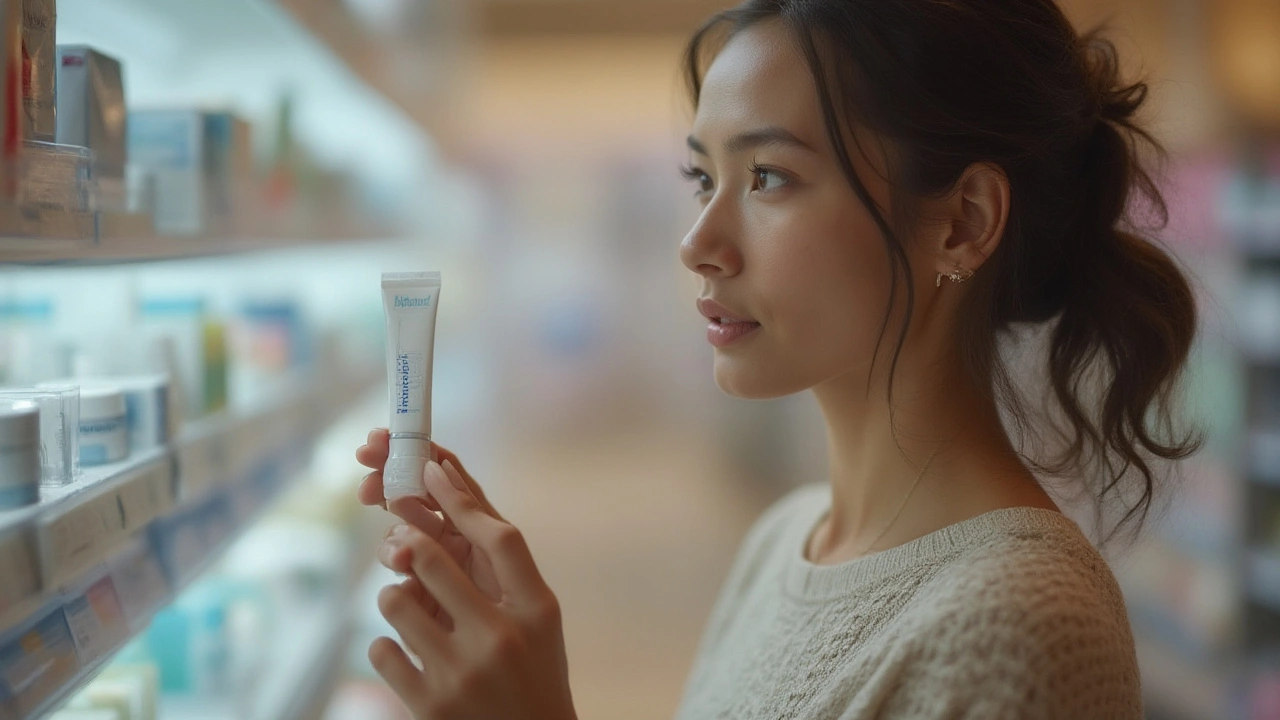Imagine waking up and noticing white patches on your skin that just refuse to blend in, no matter what you try. That’s the reality for many people living with vitiligo, and it brings more than just physical changes—it hits your confidence, too. Now, here comes Benoquin cream, a name you probably came across if you’ve ever googled solutions for long-term skin depigmentation. This skin-lightening cream lives in a world filled with myths, bold claims, and quite a bit of controversy. So, what’s the real deal?
What Is Benoquin Cream Exactly?
Let’s get straight to the facts. Benoquin cream isn’t just another cosmetic product claiming to give you flawless skin. The big difference? Its active ingredient is monobenzone. Unlike regular lightening creams that only fade melanin production, monobenzone actually strips your skin of its pigment cells. That’s a huge deal. This isn’t a moisturizer or an overnight fix for dark spots. Doctors usually prescribe Benoquin only to people with widespread vitiligo, when restoring color is no longer realistic and they want to even things out by removing the remaining pigment.
Monobenzone is seriously potent stuff. In the US, Benoquin is classified as a prescription-only drug. The U.S. Food and Drug Administration (FDA) approves its use for depigmentation therapy in extensive vitiligo—nothing else. It’s illegal and downright dangerous to use it for cosmetic skin whitening if you don’t have vitiligo. Still, the internet is full of sellers marketing it as a miracle skin-lightener. The thing is, most regular skin bleaching creams use ingredients like hydroquinone or kojic acid. Monobenzone is in a league of its own because it destroys the cells that produce melanin—the stuff that gives your skin its color.
Here’s how it works: you apply the cream to pigmented areas, and over time, it causes a gradual but irreversible loss of pigment. So, this is a lifelong commitment. Once those cells are gone, they don’t come back. That’s why doctors only prescribe Benoquin when other treatments haven’t helped and when depigmentation is what the patient truly wants. Just to put it out there—using monobenzone on normal, healthy skin can trigger unpredictable results and major skin reactions.
Who Uses Benoquin Cream?
So, who actually gets a Benoquin prescription? Mostly, it’s people dealing with severe, widespread vitiligo. Say, when more than 50% of your body is covered in white patches, and patchy recoloring treatments haven’t worked, doctors might suggest Benoquin to help even out your skin by turning all the remaining pigment white. It’s definitely not a cream for mild or early-stage vitiligo; there are less intensive options out there, including topical steroids and light therapy.
For many patients, the decision to start Benoquin is emotional. You might spend years trying to stop the spread of vitiligo, only to find it getting worse. That feeling of frustration and wanting to "start over" with a blank skin tone is completely real. But this decision isn’t made lightly—dermatologists will spend time counseling patients about the irreversible effects and the lifelong adjustments needed. Once your skin is fully depigmented, sun protection is crucial because there’s nothing left to shield you from UV rays.
A lot of people who use Benoquin report mixed feelings. Some feel a huge relief, finding a renewed sense of identity once their skin tone is even. Others feel self-conscious about becoming completely pigment-free. There’s no "right" response. For celebrities like Michael Jackson, who famously dealt with vitiligo and whose use of depigmentation therapies became a worldwide talking point, Benoquin placed the spotlight on this tough personal and medical choice.

Does Benoquin Cream Really Work?
This is the million-dollar question, right? If you follow the guidelines and actually have vitiligo, Benoquin works exactly as it’s supposed to: it removes remaining pigment and makes the skin uniformly white. But it’s slow—don’t expect overnight miracles. On average, it takes 4 to 12 months of regular application before you see a big difference. Initial results show mild lightening, then over time, bigger areas go pigment-free. Some people see patchy results at first and need to keep applying the cream to "catch up" with stubborn spots.
Doctors usually start with a small test patch to see how your skin reacts. The process goes like this:
- Apply a thin layer of Benoquin 2% or 20% cream to the pigmented areas, usually twice a day.
- Avoid applying it to unaffected (white) areas, or you might get uneven results.
- Results typically show up within 1-3 months, but full depigmentation can take a year or more.
- Even once your skin is completely depigmented, you need to maintain it with occasional use and avoid excess sun exposure.
One thing a lot of people worry about: can your skin suddenly repigment? Usually no, but in rare cases, pigment can come back in small areas (especially if you stop using the cream and get a lot of sun). Maintenance therapy is key.
Check out this quick data table based on published case reports from dermatology clinics:
| Application Frequency | Visible Results (Weeks) | Full Depigmentation (Months) |
|---|---|---|
| Once daily | 8-16 weeks | 10-16 months |
| Twice daily | 4-8 weeks | 4-12 months |
Dr. Pearl Grimes, a respected vitiligo specialist, put it perfectly:
“Benoquin isn’t a cure for vitiligo, but it can help even out skin in difficult cases. Permanent sun sensitivity is the biggest price you pay.”
Risks, Side Effects, and What to Watch For
There’s no sugarcoating it—Benoquin comes with a laundry list of risks you really should know about. For starters, here’s what’s most common:
- Redness and irritation where you apply the cream, especially in sensitive areas
- Itching, dryness, or peeling as your skin adjusts to the formula
- Patchy loss of pigment if the cream goes beyond the intended spot
- Contact dermatitis or rashes, which sometimes need medical treatment
The most serious risk: Your skin becomes completely sun-sensitive. No pigment means zero natural protection against sunlight, so even a little sun can lead to painful burns or permanent skin damage. Daily use of SPF 50+ sunscreen is essential. Most people with fully depigmented skin also wear hats, long sleeves, or UV-protective clothing. Some struggle with eyes being highly sensitive to sunlight, and freckles can still show up if you aren't careful.
If you’re allergic to the cream, you might break out in blisters or get a severe rash. Always do a small test patch or check with your dermatologist before starting full treatment. Also, never use this cream for "cosmetic skin lightening" if you don’t have vitiligo—doing so can leave you with weirdly patchy, unevenly depigmented skin and a host of other problems. The world of unlicensed online sellers is full of fakes and dangerous mixes laced with steroids or mercury. If it sounds too good to be true, it probably is.
Can Benoquin absorb into your system and cause problems elsewhere? So far, large studies show little evidence of major systemic toxicity, but it can lead to permanent skin changes and scarring if overused or misapplied. And don’t even think about using it if you’re pregnant or breastfeeding—it’s never been tested for safety in those situations.

Practical Tips and Smart Precautions for Benoquin Users
So if you’re reading this and thinking about Benoquin, here are some practical takeaways:
- Work with a board-certified dermatologist—don’t try this all by yourself.
- Always patch test a small spot before starting on larger skin areas.
- Apply thin, consistent layers only on affected skin. Don’t rub into normal skin, since it will permanently lighten those areas.
- Give it time: results can take several months, and patience is absolutely key here.
- Never, ever skip sun protection. SPF 50+ sunscreen is your new best friend.
- Visibility matters: you may need prescription sunglasses or wide-brimmed hats to manage photosensitivity.
- Keep your dermatologist updated if you get irritation, blisters, or anything unexpected—sometimes you need to pause or adjust treatment.
- Store your Benoquin cream away from heat and sunlight. It has a shelf life of about 1-2 years, so don’t stockpile expired tubes.
- If you travel to places with lots of UV radiation, plan extra sun cover and carry your cream with you.
- Be prepared for emotional ups and downs. Joining a support group—online or in person—can really help.
Quick fun fact: Some people report areas of repigmentation after stopping Benoquin, but this usually happens if treatment was inconsistent or if you get intense sun exposure. Maintenance therapy nips this in the bud.
Not everyone qualifies for Benoquin, and getting a proper diagnosis of your skin condition is the first step. Vitiligo mimics other conditions, and you genuinely need a doctor’s confirmation and a conversation about those long-term effects before starting.
If you’re curious about the science, monobenzone’s pigment-destroying power has even made it a subject of research in melanoma and other pigmentation disorders. Still, its job in everyday medicine is all about helping people with severe vitiligo finally reclaim control over their skin tone.
To wrap it up: Benoquin cream is a big decision, not just another skincare product. It offers real hope for people with widespread vitiligo but demands a careful approach, strict sun protection, and a willingness to accept lifelong change. If you ever spot an online seller pitching Benoquin as a "beauty secret" for instant whitening—run the other way. Do your research, talk to a real doctor, and treat your skin with the respect it deserves.

Deepak Bhatia
Thanks for sharing this guide on Benoquin cream. It’s really helpful to see a balanced view, especially about the pros and cons. Skin lightening products can be quite sensitive topics, so it’s good to approach them carefully.
From what I understand, Benoquin works by targeting pigment-producing cells, which can be effective but might have risks if not used properly. I always recommend starting with a patch test and consulting a dermatologist before using any cream like this.
Does anyone here have personal experience with how long the effects take to show? Also, how do you manage the side effects, especially skin irritation?
Andy McCullough
Great post! Benoquin's mechanism involving monobenzone indeed makes it unique, but it’s not without caveats. The depigmentation it causes is due to irreversible melanocyte destruction, which means the lightening effect is permanent in many cases.
It’s crucial to note that this can also lead to significant complications, such as post-inflammatory hypopigmentation and even an increased risk for sunburn or skin cancer because of the loss of protective melanin. Users should be very cautious with sun exposure and always use Sunscreen SPF 50+.
Also, the immunological aspect—that monobenzone can sometimes trigger vitiligo-like effects—is something to be aware of. The guide you shared touches on side effects, but I'd emphasize users monitoring themselves closely and consulting professionals regularly.
Samantha Gavrin
Honestly, I’m always skeptical about these skin lightening creams. There’s a whole conspiracy about big skincare corporations hiding the real dangers.
Benoquin doesn’t just lighten skin; it essentially kills pigment cells. That sounds a bit extreme, if you ask me. What if there are long-term irreversible damages that they don’t advertise? And who really regulates these creams to ensure they’re safe?
Plus, the fact that it can cause vitiligo-like symptoms—shouldn’t that be a huge red flag? I’d caution everyone to thoroughly research and maybe avoid stuff like this unless absolutely necessary. Your skin is your natural defense, don’t mess with it lightly.
NIck Brown
Honestly, the whole idea of using Benoquin to alter your skin tone permanently is kind of disturbing. I get that people want to change themselves, but there’s something to be said about embracing your natural complexion.
From a societal perspective, using such creams might inadvertently promote problematic beauty standards. It’s a slippery slope when the motivation is tied to societal pressures rather than pure personal preference.
That said, if anyone chooses to use Benoquin, it’s absolutely critical to be informed and cautious because the effects are long lasting, and not without risk.
Vikas Kale
For those interested in the pharmacodynamics, monobenzone—the active compound in Benoquin—is a phenolic compound that leads to melanocyte cytotoxicity. This is why it creates significant skin lightening but at the cost of pigment cell death.
Clinically, it’s used in vitiligo patients to depigment unaffected skin to achieve uniformity, but widespread cosmetic use is off-label and fraught with risks.
One should also consider potential systemic absorption leading to autoimmunity concerns, though rare. Always follow protocols for sun protection after use. It’s not a cream you just casually slap on.
Buddy Sloan
Hey all! 😊 I’ve seen some mixed reviews about this stuff, so it’s nice to see a thorough guide posted here. I think an important point is that not everyone’s skin will react the same way. Some people might tolerate Benoquin well, others might get redness or discomfort.
Personally, I found moisturizing regularly and avoiding direct sun exposure helped reduce irritation. Always patch test before widespread use to avoid nasty surprises! And patience is key; results don’t happen overnight.
What about you guys? Any safe routines you swear by while using skin lightening creams?
Zackery Brinkley
This guide truly brings a comprehensive yet simple explanation, which is appreciated. I also find it important to stress the mental and emotional aspect during such treatments. Skin changes can impact one’s confidence and psychological well-being profoundly.
Users should prepare themselves for the gradual transformation process, and if side effects arise, seek support—not just physical treatment but emotional support from friends or counselors.
Taking care during application—such as applying only on target areas and avoiding broken skin—is essential to avoid unintended consequences.
Amanda Devik
There’s something quite fascinating yet delicate about using a product like Benoquin. It’s a powerful chemical with deep implications for identity and self-perception.
Many underestimate the emotional layers involved in altering one’s skin color, which is intertwined so closely with culture, heritage, and self-expression. This guide does a good job outlining practical tips, but I think we also need to respect the philosophical side of it.
In any case, safe usage is paramount. Overuse or improper application can lead to unwanted outcomes, so following doctor’s directions and listening to your body are non-negotiables.
Roberta Giaimo
Just a quick reminder about grammar and clarity when talking about these products in posts and discussions! It helps everyone understand the risks and benefits clearly.
For instance, saying things like "Benoquin 'kills' pigment cells" might scare some off unnecessarily; better to phrase it as "Benoquin irreversibly alters melanin production by depleting melanocytes." Precision helps a lot.
Also, including reminders to avoid sunburn and to use sunscreen consistently could be highlighted more in these guides.
Thanks for the useful info overall! 😊
David Stephen
Reading through all these perspectives, I feel it’s important to highlight inclusivity and personal choice with respect to skin treatments. Whatever your reasons for exploring something like Benoquin cream, your safety and well-being come first.
Keep discussions respectful and supportive. Encourage users to research deeply, consult with medical professionals, and reflect on the motivations behind usage. This approach helps everyone make informed, empowered decisions.
If anyone has questions about managing side effects or alternative treatments, I’m here to help!
Elle Batchelor Peapell
This topic raises deep questions about identity and transformation. Using Benoquin is not just about changing appearance but can be a journey that challenges what we consider innate.
It is worth pondering how society’s standards influence these choices and whether we seek change for empowerment or conformity. This guide is detailed and useful, but the emotional and philosophical impacts deserve space in the conversation.
In the end, every individual’s experience will be unique, and respectful dialogue should continue alongside practical advice.